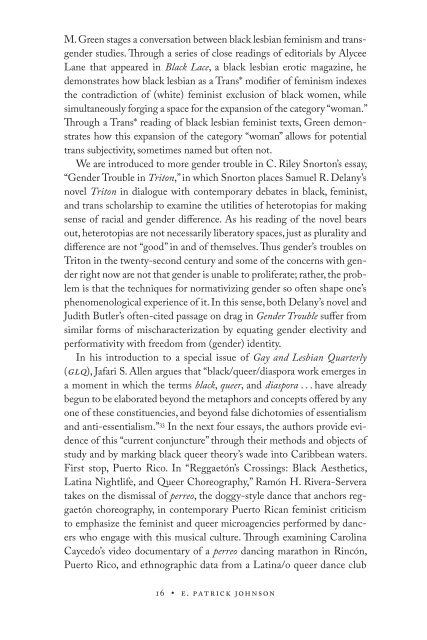No Tea
89AS6wvrf
89AS6wvrf
You also want an ePaper? Increase the reach of your titles
YUMPU automatically turns print PDFs into web optimized ePapers that Google loves.
M. Green stages a conversation between black lesbian feminism and transgender<br />
studies. Through a series of close readings of editorials by Alycee<br />
Lane that appeared in Black Lace, a black lesbian erotic magazine, he<br />
demonstrates how black lesbian as a Trans* modifier of feminism indexes<br />
the contradiction of (white) feminist exclusion of black women, while<br />
si mul ta neously forging a space for the expansion of the category “ woman.”<br />
Through a Trans* reading of black lesbian feminist texts, Green demonstrates<br />
how this expansion of the category “ woman” allows for potential<br />
trans subjectivity, sometimes named but often not.<br />
We are introduced to more gender trou ble in C. Riley Snorton’s essay,<br />
“Gender Trou ble in Triton,” in which Snorton places Samuel R. Delany’s<br />
novel Triton in dialogue with con temporary debates in black, feminist,<br />
and trans scholarship to examine the utilities of heterotopias for making<br />
sense of racial and gender difference. As his reading of the novel bears<br />
out, heterotopias are not necessarily liberatory spaces, just as plurality and<br />
difference are not “good” in and of themselves. Thus gender’s trou bles on<br />
Triton in the twenty- second century and some of the concerns with gender<br />
right now are not that gender is unable to proliferate; rather, the problem<br />
is that the techniques for normativizing gender so often shape one’s<br />
phenomenological experience of it. In this sense, both Delany’s novel and<br />
Judith Butler’s often- cited passage on drag in Gender Trou ble suffer from<br />
similar forms of mischaracterization by equating gender electivity and<br />
performativity with freedom from (gender) identity.<br />
In his introduction to a special issue of Gay and Lesbian Quarterly<br />
(glq), Jafari S. Allen argues that “black/queer/diaspora work emerges in<br />
a moment in which the terms black, queer, and diaspora . . . have already<br />
begun to be elaborated beyond the meta phors and concepts offered by any<br />
one of these constituencies, and beyond false dichotomies of essentialism<br />
and anti- essentialism.” 33 In the next four essays, the authors provide evidence<br />
of this “current conjuncture” through their methods and objects of<br />
study and by marking black queer theory’s wade into Ca rib bean waters.<br />
First stop, Puerto Rico. In “Reggaetón’s Crossings: Black Aesthetics,<br />
Latina Nightlife, and Queer Choreography,” Ramón H. Rivera- Servera<br />
takes on the dismissal of perreo, the doggy- style dance that anchors reggaetón<br />
choreography, in con temporary Puerto Rican feminist criticism<br />
to emphasize the feminist and queer microagencies performed by dancers<br />
who engage with this musical culture. Through examining Carolina<br />
Caycedo’s video documentary of a perreo dancing marathon in Rincón,<br />
Puerto Rico, and ethnographic data from a Latina/o queer dance club<br />
16 • E. Patrick Johnson


